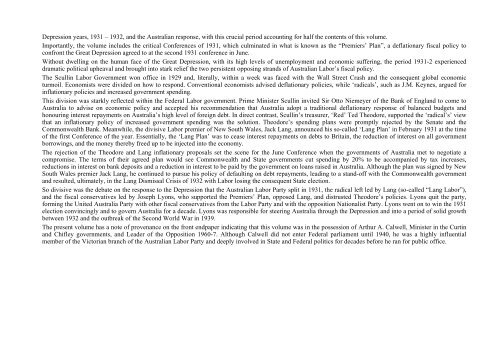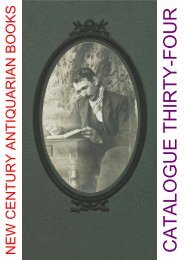Catalogue 63 New Century Antiquarian Books Late Spring 2012
Catalogue 63 New Century Antiquarian Books Late Spring 2012
Catalogue 63 New Century Antiquarian Books Late Spring 2012
You also want an ePaper? Increase the reach of your titles
YUMPU automatically turns print PDFs into web optimized ePapers that Google loves.
Depression years, 1931 – 1932, and the Australian response, with this crucial period accounting for half the contents of this volume.<br />
Importantly, the volume includes the critical Conferences of 1931, which culminated in what is known as the “Premiers’ Plan”, a deflationary fiscal policy to<br />
confront the Great Depression agreed to at the second 1931 conference in June.<br />
Without dwelling on the human face of the Great Depression, with its high levels of unemployment and economic suffering, the period 1931-2 experienced<br />
dramatic political upheaval and brought into stark relief the two persistent opposing strands of Australian Labor’s fiscal policy.<br />
The Scullin Labor Government won office in 1929 and, literally, within a week was faced with the Wall Street Crash and the consequent global economic<br />
turmoil. Economists were divided on how to respond. Conventional economists advised deflationary policies, while ‘radicals’, such as J.M. Keynes, argued for<br />
inflationary policies and increased government spending.<br />
This division was starkly reflected within the Federal Labor government. Prime Minister Scullin invited Sir Otto Niemeyer of the Bank of England to come to<br />
Australia to advise on economic policy and accepted his recommendation that Australia adopt a traditional deflationary response of balanced budgets and<br />
honouring interest repayments on Australia’s high level of foreign debt. In direct contrast, Scullin’s treasurer, ‘Red’ Ted Theodore, supported the ‘radical’s’ view<br />
that an inflationary policy of increased government spending was the solution. Theodore’s spending plans were promptly rejected by the Senate and the<br />
Commonwealth Bank. Meanwhile, the divisive Labor premier of <strong>New</strong> South Wales, Jack Lang, announced his so-called ‘Lang Plan’ in February 1931 at the time<br />
of the first Conference of the year. Essentially, the ‘Lang Plan’ was to cease interest repayments on debts to Britain, the reduction of interest on all government<br />
borrowings, and the money thereby freed up to be injected into the economy.<br />
The rejection of the Theodore and Lang inflationary proposals set the scene for the June Conference when the governments of Australia met to negotiate a<br />
compromise. The terms of their agreed plan would see Commonwealth and State governments cut spending by 20% to be accompanied by tax increases,<br />
reductions in interest on bank deposits and a reduction in interest to be paid by the government on loans raised in Australia. Although the plan was signed by <strong>New</strong><br />
South Wales premier Jack Lang, he continued to pursue his policy of defaulting on debt repayments, leading to a stand-off with the Commonwealth government<br />
and resulted, ultimately, in the Lang Dismissal Crisis of 1932 with Labor losing the consequent State election.<br />
So divisive was the debate on the response to the Depression that the Australian Labor Party split in 1931, the radical left led by Lang (so-called “Lang Labor”),<br />
and the fiscal conservatives led by Joseph Lyons, who supported the Premiers’ Plan, opposed Lang, and distrusted Theodore’s policies. Lyons quit the party,<br />
forming the United Australia Party with other fiscal conservatives from the Labor Party and with the opposition Nationalist Party. Lyons went on to win the 1931<br />
election convincingly and to govern Australia for a decade. Lyons was responsible for steering Australia through the Depression and into a period of solid growth<br />
between 1932 and the outbreak of the Second World War in 1939.<br />
The present volume has a note of provenance on the front endpaper indicating that this volume was in the possession of Arthur A. Calwell, Minister in the Curtin<br />
and Chifley governments, and Leader of the Opposition 1960-7. Although Calwell did not enter Federal parliament until 1940, he was a highly influential<br />
member of the Victorian branch of the Australian Labor Party and deeply involved in State and Federal politics for decades before he ran for public office.














